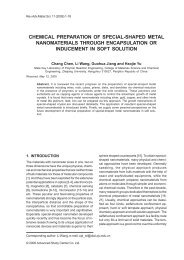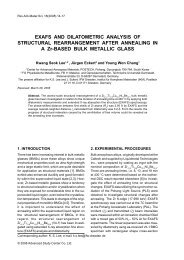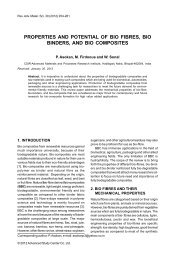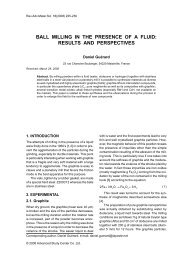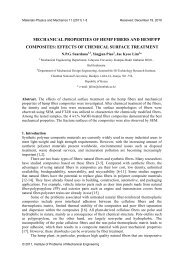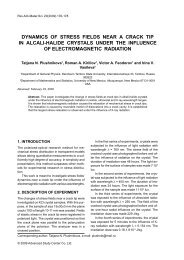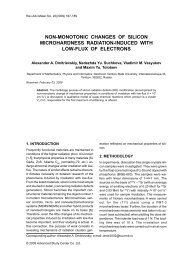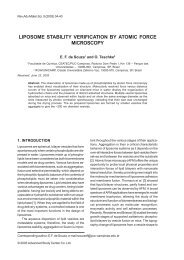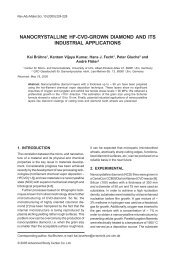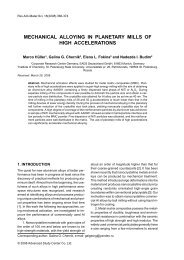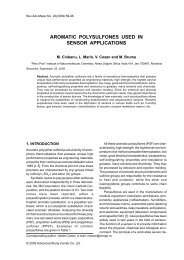surface pretreatment by phosphate conversion coatings – a review
surface pretreatment by phosphate conversion coatings – a review
surface pretreatment by phosphate conversion coatings – a review
Create successful ePaper yourself
Turn your PDF publications into a flip-book with our unique Google optimized e-Paper software.
166 T.S.N. Sankara Narayanan<br />
The Nd<strong>–</strong>Fe<strong>–</strong>B type magnets are highly susceptible<br />
to attack from both climatic and corrosive environments,<br />
which result in corrosion of the alloy and<br />
deterioration in both its physical and magnetic properties.<br />
The poor corrosion resistance of Nd<strong>–</strong>Fe<strong>–</strong>B<br />
type magnets in many aggressive environments is<br />
associated with the presence of ~ 35 wt.% of neodymium<br />
in their composition. Neodymium, along with<br />
other rare earth (RE) elements belongs among the<br />
most electrochemically active metals. The application<br />
of a zinc <strong>phosphate</strong> coating proved to be a most<br />
useful method to improve the corrosion resistance<br />
of NdFeB magnet [377,378]. The improvement in<br />
corrosion resistance of NdFeB magnet following the<br />
application of a zinc <strong>phosphate</strong> coating is shown in<br />
Fig. 19.<br />
Phosphating is a widely used method of reducing<br />
wear on machine elements and moving parts<br />
[379,380]. Phosphate <strong>coatings</strong> function as lubricants,<br />
in addition their ability to retain oils and soaps<br />
further enhances this action. Heavy manganese<br />
<strong>phosphate</strong> <strong>coatings</strong>, supplemented with proper lubricants<br />
are most commonly used for wear resistance<br />
applications [381]. The manganese <strong>phosphate</strong>s<br />
widely used in automotive industry are the<br />
best to improve the ease of sliding and the reduction<br />
of associated wear of two steel <strong>surface</strong>s sliding<br />
one against the other. The <strong>phosphate</strong> <strong>coatings</strong> pos-<br />
sess no intrinsic lubricating properties but can absorb<br />
or hold a considerable quantity of lubricant <strong>by</strong><br />
virtue of their porosity [382,383]. This combination<br />
favours an easier running-in at higher <strong>surface</strong> pressures<br />
<strong>by</strong> forming a non-metallic barrier that separates<br />
the two metal <strong>surface</strong>s and reduces the danger<br />
of seizure and associated pitting. There is also<br />
less noise produced at such <strong>surface</strong>s and they have<br />
an in-built capacity, in emergencies, to run dry for a<br />
limited period [384]. Phosphating increases the sliding<br />
distance to scuffing as well as the scuffing load,<br />
whilst marginally reducing the coefficient of friction.<br />
No advantage was found in phosphating dry sliding<br />
<strong>surface</strong>s. Phosphating reduces the likelihood of<br />
adhesive wear in marginal or poorly lubricated sliding<br />
couples. The choice of <strong>phosphate</strong> coating is<br />
primarily dependent on the <strong>surface</strong> finish of the sliding<br />
counterface; thin <strong>coatings</strong> are suitable for smooth<br />
<strong>surface</strong>s whereas against rougher <strong>surface</strong>s thicker<br />
<strong>coatings</strong> are preferred [385].<br />
The power used in deep drawing operations, sets<br />
up a great amount of friction between the steel <strong>surface</strong><br />
and the die. This will decrease the speed of<br />
drawing operation and the service life of tools and<br />
dies [386,387]. Application of light to medium weight<br />
non-metallic zinc <strong>phosphate</strong> coating to steel <strong>surface</strong>s,<br />
which permit the distribution and retention of<br />
a uniform film of lubricant over the entire <strong>surface</strong>,<br />
Fig. 19. Potentiodynamic polarization curves of NdFeB magnet in 3.5% sodium chloride solution (a) Uncoated<br />
NdFeB magnet; and (b) Zinc <strong>phosphate</strong> coated NdFeB magnet.



